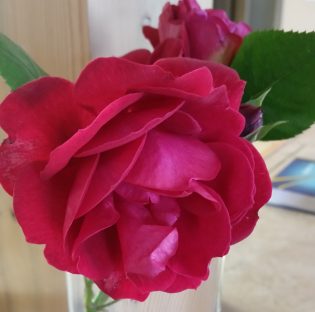Bloomin’ Roses
Roses are grown for their beautiful blooms, so you want to be able to get as many blooms as possible and still maintain a healthy plant.
By now, many of the rose bushes have already gone through their first flush of flowers and if cared for properly they will produce a second flush. To get that second flush of flowers the old finished flowers from the first flush need to be removed before they form rose hips. Rose hips contain seeds and it takes a lot of energy from the plant to form those seeds. Instead, you want the plant’s energy to go towards producing new flowers.
Remove the finished flowers as soon as they have finished blooming. The finished flowers can be removed singularly or as a clump. Cut the stem that has finished flowering back to just above the nearest outside facing five-leaf junction. Choose an outside facing leaf junction to promote the new growth to grow outwards which keeps the centre of the bush open creating better air circulation in the centre of the bush. Air circulation is important when growing roses as it helps prevent mildew and fungus which roses are prone to, especially during wet, conditions. When cutting the stem, cut the stem on a slight angle, so that the moisture runs off the cut edge. Roses can have the finished roses removed until mid August and then after mid August the finished roses should be left on the plant to form rose hips, as this will indicate to the plant to get ready for winter. Rose hips left on the plant over winter add winter interest to the landscape.
Roses are heavy feeders especially when producing flowers, so should be fed regularly. There are granular fertilizers available such as 6-8-12 which is applied every 4-6 weeks or water soluble rose food that is applied weekly. Always be careful when fertilizing, following the directions as you don’t want to over fertilize which will cause the leaves to burn. By mid August stop fertilizing as you want the plant to go into dormancy for the winter months.
It may not be a problem right now due to the recent rain we’ve been receiving, but during dry spells roses need to be watered. Ideally, the water should be directed to the soil that surrounds the rose, rather than on the rose itself. A soaker hose works well as it slowly saturates the soil and gives the plant a thorough water. If you must overhead water, do so in the morning so that the plants foliage can dry quickly and will not be wet over night when temperatures are cool which can lead to mildew or blackspot.
Roses can be prone to fungus disease and should be checked carefully. Powdery mildew is a fungus which looks like grey/white powder on the surface of the leave, stem or bud. Remove and destroy any infected leaves immediately before it gets a chance to spread. Treating the plant with a garden fungicide will help. Blackspot is another fungus problem causing the leaves to get dark spots, turn yellow and fall off. It should be dealt with quickly as it can seriously harm the plant.
Some of the more common pests to watch for on roses are aphids and spider mites. Both of these are sap sucking insects that. Aphids are small, green soft-bodied that can be found on new growth, foliage and buds. They can be removed by hand or a blast of water from the hose or by applying insecticidal soap to the plant on a regular basis. Spider mites are usually not noticed until the damage they have created is noticed. Leaves will become mottled and dry and fall off. In severe cases the leaves will be encased in a very fine webbing. The spider mite itself is very tiny and can hardly be seen and are most often on the undersides of the leave. Insecticidal soap on a regular basis or Malathion should help control spider mites.
Healthy roses will not only bloom more but are able to fight off disease and pests better as well as be able to survive the winter!
- -Jos
Jos Van Hage owns and operates two Art Knapp Home and Garden Centres in Prince George”
- Highway 16 West at Kimball Road
- Highway 97 North at Northwood Pulpmill Road


Comments
Comments for this article are closed.